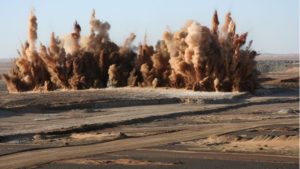Dynamic Drill and Blast executive director Matt Freedman on the WA driller’s successful first year on the ASX

Pic: Betsie Van der Meer/DigitalVision via Getty Images.
It has been a little more than a year since Dynamic Drill and Blast (ASX:DDB) listed on the ASX as part of a wave of mining services floats that also included DDH1 (ASX:DDH) and MLG OZ (ASX:MLG).
With a 180 per cent gain in 2020 it closed the year as the third top performing IPO and while it is down around 20% year to date, the Perth-based driller is still double its listing price and has consolidated with a strong set of numbers in its maiden end of year financials.
The $40 million capped Dynamic posted revenues of more than $58 million in 2021, generating EBITDA of $12.9 million.
That includes a $7.9m EBITDA contribution from Orlando Drilling, the resource definition and grade control drilling experts Dynamic paid $21.4 million to acquire in July.
As executive director Matt Freedman tells Stockhead, the deal gives Dynamic exposure to the full life cycle of mining and exploration amid strong market conditions for explorers and miners across the metals complex.
What is the market like for drill and blast services at the moment? Is the resource industry or commodities just going gangbusters? Is there work everywhere? Or is it not quite as rosy as it seems from the outside?
“Just to give a bit of context, we were listed this business back in August last year, Dynamic. And we recently acquired a business, Orlando Drilling.
“So we’ve got two wholly owned subsidiaries of Dynamic, being Dynamic Drill and Blast and Orlando Drilling. Orlando Drilling focuses on exploration and resource definition.
“Dynamic, as the name suggests, focuses on mining production projects, as well as construction and close proximity specialised blasting with the sensitive stuff that’s required for that. So whether you’re blasting close to rail or existing structure, that sort of thing.
“So from a drill and blast perspective, we’re seeing an unprecedented amount of inquiries coming through both formal and non-formal.
“And obviously, the same goes for the exploration and grade control.
“And it gives us the sort of look through to be able to say, ‘OK we’ve got current customers in production phase, but they need to get that resource definition and grade control activity happening’.
“So we’re really seeing additional activity to what is already quite a buoyant market, we’re seeing even more opportunities flow through from business unit to business unit or business to business, with the sharing of information. Customers really want it in that single point, to be able to go end to end on their drilling provision.”
Dynamic Drill and Blast share price today:
Is there a particular commodity that you’re finding more of your business in than another?
“It’s an interesting one. So predominantly Orlando have currently got a lot of gold exposure, doing a lot of work in the gold space, as you’d expect in the resource definition and exploration capacity that they provide.”
“Whereas Dynamic really has a lot of iron ore. And with Galaxy or Orocobre now, I should say, we’ve earned our second term there (at the Mt Cattlin lithium mine), we’ve been there for a number of years.”
“So we’ve got a really good mix of commodities in our portfolio between the majors being iron ore, gold and lithum, but as well a bit of copper, nickel, and other commodities as well.”
“So that was another reason for the transaction that we undertook or the acquisition that we completed, was to get that revenue mix right across the group. We are seeing a large level of inquiry through particularly the gold space.
“And with the highs of where iron ore has been, we certainly saw a high level of inquiry there.”
You generated $12.9 million of EBITDA in the last financial year. Are those sorts of results putting drilling companies more on the radar of institutional investors than they would have been beforehand. Are you finding there’s more interest now from sophisticated and institutional investors in drilling companies?
“We are, I think that the market’s obviously helped. But there’s been other corporate activity in the sector, which is what has raised I guess, the awareness in our space.
“And the incoming inquiries, particularly from, you say, sophisticated and some of the institutional guys is certainly gathering some momentum.”
What’s your your shareholder base like at the moment? Do you have any sort of big funds in there?
“We don’t. The register is quite heavily weighted towards the cornerstone investors that came in at the IPO stage, as well as the keenness of executive and management, including myself and our managing director, to remain involved in this business.”
“We’ve got around 70% of the register is held in the top, I think it’s seven names.
“So that’s something at our early phase being a relatively small company still at around $50 million market cap, we do have a fair bit of the register held within guys with skin in the game, and we see that as a very important structure to grow the business into something significant.”
In terms of the outlook for new drilling activity in exploration, resource definition and drilling and blasting, is the outlook pretty solid over the next sort of 12 to 18 months? Can you look forward at your order book and say that there’s a lot of business coming in, and are there inquiries over the top of that showing the strength of the resources market at the moment?
“Absolutely. This is a common misconception of exploration and grade control drlling, in particular. People say it’s a hot market, of course, it’s going to be running.”
“What we’re seeing is longer term planning and lessons learned from previous highs in the space on the principal’s side, on the miners’ side.”
“So (clients are saying) how are we going to ensure the sustainability of a business? How are we going to make sure we know where the resource is and we know where the ore finishes and the waste starts. And we’re seeing more proactive planning, resulting in tendering activity and the longer term contracts that we’ve got in place.”
“We’ve got a really great mix of long term contracts, as well as short term, high margin jobs, particular in the construction space, that sort of thing, but we are seeing sustainable tendering activity with projects starting not only yesterday, but into the future in quite a steady manner with capital being approved for these projects. And you know, at the junior end, funding (is) being (made) available.”
Is it difficult to find labour to man drill rigs, work in your maintenance crews, work on things like building new drill rigs, if you need them? Drilling in particular is a pretty highly skilled role. There always seems to be regular issues to find people with those skill sets, regardless of what the market’s like.
“Look, there’s so much around labor shortages in the press and in the market at the moment. We’re not seeing it impact us directly. We’ve been for a long time working on attraction and retention strategies and using your brand equity and culture to do that work for you, as well as you know, financial and non-financial incentives also.”
“In short, it is difficult to attract and retain people more so than in a softer environment. But we are working through it, we’ve got really good people in our teams, we’ve got a great HR team.”
“It’s about giving guys stability, the continuity of work, and obviously rewarding appropriately for the space they’re in.
“On equipment, lead times are pushing out certainly. A key sort of piece when we’re building our shareholder base and the register early on, was about getting highly strategic investors involved that have been in the industry for a long time, as well as you know, getting the corporate support that we have.”
“But we’ve got guys that have access to the gray iron market also. So if we need to have access to equipment that the lead times on new is too long, we have a good global network of gray iron.
“As well as being able to bring in low hour second-hand units and then use our in-house maintenance capability to be able to give the equipment a bit of a birthday and get it out to work in the event we need to mitigate the long lead times that we’re seeing on new equipment in country.”
What’s the growth profile looking like for the business over the next year, and additionally, in terms of rates; with there being a bit more tightness in the market are we seeing rates for drill rigs and drilling starting to increase a little bit after they would have taken a big hit during the downturn?
“At this stage we’re not providing any forecasts, we’re really thrilled about combined results in excess of $58 million revenue at $12.9m of EBITDA and a really strong balance sheet position of $39.4 million of net assets.”
“In terms of the conditions and the pricing … obviously there are price increases around the place that you’re able to table that you might not have been able to previously.
“But we’re seeing a greater willingness to agree to terms that derisk our business; that’s been a large focus of ours over the last couple of years.
“And it was part of the preparation for our growth phase where, you’re moving from, for example, fully variable contracts into fixed and variable contracts where you’re recovering your capital items, protecting your position, particularly in long term jobs, and derisking to a certain degree.”
Related Topics
UNLOCK INSIGHTS
Discover the untold stories of emerging ASX stocks.
Daily news and expert analysis, it's free to subscribe.
By proceeding, you confirm you understand that we handle personal information in accordance with our Privacy Policy.








